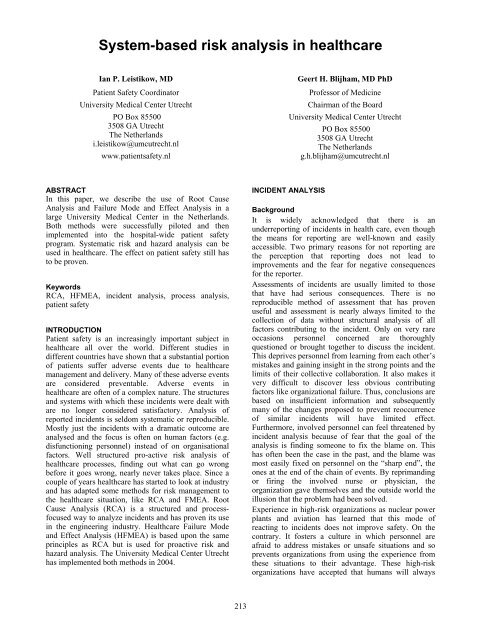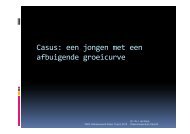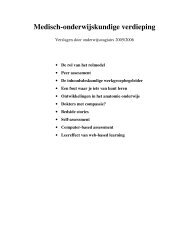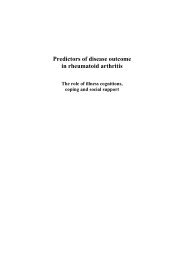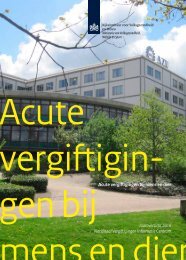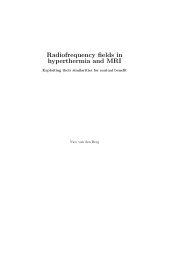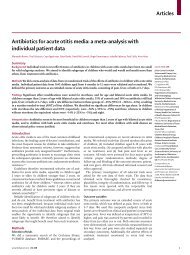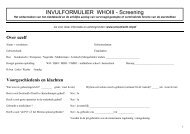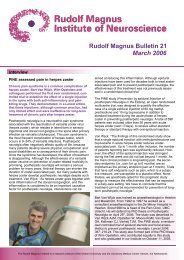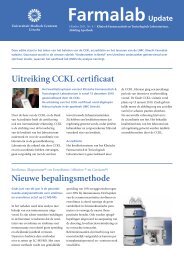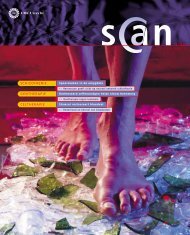System-based risk analysis in healthcare
System-based risk analysis in healthcare
System-based risk analysis in healthcare
You also want an ePaper? Increase the reach of your titles
YUMPU automatically turns print PDFs into web optimized ePapers that Google loves.
<strong>System</strong>-<strong>based</strong> <strong>risk</strong> <strong>analysis</strong> <strong>in</strong> <strong>healthcare</strong><br />
Ian P. Leistikow, MD<br />
Patient Safety Coord<strong>in</strong>ator<br />
University Medical Center Utrecht<br />
PO Box 85500<br />
3508 GA Utrecht<br />
The Netherlands<br />
i.leistikow@umcutrecht.nl<br />
www.patientsafety.nl<br />
Geert H. Blijham, MD PhD<br />
Professor of Medic<strong>in</strong>e<br />
Chairman of the Board<br />
University Medical Center Utrecht<br />
PO Box 85500<br />
3508 GA Utrecht<br />
The Netherlands<br />
g.h.blijham@umcutrecht.nl<br />
ABSTRACT<br />
In this paper, we describe the use of Root Cause<br />
Analysis and Failure Mode and Effect Analysis <strong>in</strong> a<br />
large University Medical Center <strong>in</strong> the Netherlands.<br />
Both methods were successfully piloted and then<br />
implemented <strong>in</strong>to the hospital-wide patient safety<br />
program. <strong>System</strong>atic <strong>risk</strong> and hazard <strong>analysis</strong> can be<br />
used <strong>in</strong> <strong>healthcare</strong>. The effect on patient safety still has<br />
to be proven.<br />
Keywords<br />
RCA, HFMEA, <strong>in</strong>cident <strong>analysis</strong>, process <strong>analysis</strong>,<br />
patient safety<br />
INTRODUCTION<br />
Patient safety is an <strong>in</strong>creas<strong>in</strong>gly important subject <strong>in</strong><br />
<strong>healthcare</strong> all over the world. Different studies <strong>in</strong><br />
different countries have shown that a substantial portion<br />
of patients suffer adverse events due to <strong>healthcare</strong><br />
management and delivery. Many of these adverse events<br />
are considered preventable. Adverse events <strong>in</strong><br />
<strong>healthcare</strong> are often of a complex nature. The structures<br />
and systems with which these <strong>in</strong>cidents were dealt with<br />
are no longer considered satisfactory. Analysis of<br />
reported <strong>in</strong>cidents is seldom systematic or reproducible.<br />
Mostly just the <strong>in</strong>cidents with a dramatic outcome are<br />
analysed and the focus is often on human factors (e.g.<br />
disfunction<strong>in</strong>g personnel) <strong>in</strong>stead of on organisational<br />
factors. Well structured pro-active <strong>risk</strong> <strong>analysis</strong> of<br />
<strong>healthcare</strong> processes, f<strong>in</strong>d<strong>in</strong>g out what can go wrong<br />
before it goes wrong, nearly never takes place. S<strong>in</strong>ce a<br />
couple of years <strong>healthcare</strong> has started to look at <strong>in</strong>dustry<br />
and has adapted some methods for <strong>risk</strong> management to<br />
the <strong>healthcare</strong> situation, like RCA and FMEA. Root<br />
Cause Analysis (RCA) is a structured and processfocused<br />
way to analyze <strong>in</strong>cidents and has proven its use<br />
<strong>in</strong> the eng<strong>in</strong>eer<strong>in</strong>g <strong>in</strong>dustry. Healthcare Failure Mode<br />
and Effect Analysis (HFMEA) is <strong>based</strong> upon the same<br />
pr<strong>in</strong>ciples as RCA but is used for proactive <strong>risk</strong> and<br />
hazard <strong>analysis</strong>. The University Medical Center Utrecht<br />
has implemented both methods <strong>in</strong> 2004.<br />
INCIDENT ANALYSIS<br />
Background<br />
It is widely acknowledged that there is an<br />
underreport<strong>in</strong>g of <strong>in</strong>cidents <strong>in</strong> health care, even though<br />
the means for report<strong>in</strong>g are well-known and easily<br />
accessible. Two primary reasons for not report<strong>in</strong>g are<br />
the perception that report<strong>in</strong>g does not lead to<br />
improvements and the fear for negative consequences<br />
for the reporter.<br />
Assessments of <strong>in</strong>cidents are usually limited to those<br />
that have had serious consequences. There is no<br />
reproducible method of assessment that has proven<br />
useful and assessment is nearly always limited to the<br />
collection of data without structural <strong>analysis</strong> of all<br />
factors contribut<strong>in</strong>g to the <strong>in</strong>cident. Only on very rare<br />
occasions personnel concerned are thoroughly<br />
questioned or brought together to discuss the <strong>in</strong>cident.<br />
This deprives personnel from learn<strong>in</strong>g from each other’s<br />
mistakes and ga<strong>in</strong><strong>in</strong>g <strong>in</strong>sight <strong>in</strong> the strong po<strong>in</strong>ts and the<br />
limits of their collective collaboration. It also makes it<br />
very difficult to discover less obvious contribut<strong>in</strong>g<br />
factors like organizational failure. Thus, conclusions are<br />
<strong>based</strong> on <strong>in</strong>sufficient <strong>in</strong>formation and subsequently<br />
many of the changes proposed to prevent reoccurrence<br />
of similar <strong>in</strong>cidents will have limited effect.<br />
Furthermore, <strong>in</strong>volved personnel can feel threatened by<br />
<strong>in</strong>cident <strong>analysis</strong> because of fear that the goal of the<br />
<strong>analysis</strong> is f<strong>in</strong>d<strong>in</strong>g someone to fix the blame on. This<br />
has often been the case <strong>in</strong> the past, and the blame was<br />
most easily fixed on personnel on the “sharp end”, the<br />
ones at the end of the cha<strong>in</strong> of events. By reprimand<strong>in</strong>g<br />
or fir<strong>in</strong>g the <strong>in</strong>volved nurse or physician, the<br />
organization gave themselves and the outside world the<br />
illusion that the problem had been solved.<br />
Experience <strong>in</strong> high-<strong>risk</strong> organizations as nuclear power<br />
plants and aviation has learned that this mode of<br />
react<strong>in</strong>g to <strong>in</strong>cidents does not improve safety. On the<br />
contrary. It fosters a culture <strong>in</strong> which personnel are<br />
afraid to address mistakes or unsafe situations and so<br />
prevents organizations from us<strong>in</strong>g the experience from<br />
these situations to their advantage. These high-<strong>risk</strong><br />
organizations have accepted that humans will always<br />
213
make mistakes. Report<strong>in</strong>g a mistake or unsafe situation<br />
is seen as positive behaviour because it creates the<br />
opportunity to cont<strong>in</strong>uously redesigned the systems <strong>in</strong><br />
such a way that mistakes are detected and <strong>in</strong>tercepted<br />
before they lead to unsafe situations.<br />
Incident report<strong>in</strong>g and <strong>analysis</strong> <strong>in</strong> health care is <strong>in</strong> it’s<br />
<strong>in</strong>fancy. We look towards other high-<strong>risk</strong> <strong>in</strong>dustry to<br />
learn how we can change this situation for the better.<br />
One way is to <strong>in</strong>troduce a systematic and reproducible<br />
method to analyse <strong>in</strong>cidents multidiscipl<strong>in</strong>ary <strong>in</strong> a<br />
blame-free environment. Root Cause Analysis (RCA) is<br />
such a method.<br />
Root Cause Analysis<br />
RCA is a structured and process-focused way to analyse<br />
<strong>in</strong>cidents without relaps<strong>in</strong>g to “blam<strong>in</strong>g and sham<strong>in</strong>g”.<br />
Organizational factors can be identified, acknowledged<br />
and addressed, giv<strong>in</strong>g personnel the chance to suggest<br />
improvements of these factors. This way the personnel<br />
get a chance to learn from the adverse event and the<br />
organization can make effective changes to reduce the<br />
likelihood of future <strong>in</strong>cidents. Thorough <strong>analysis</strong> of an<br />
adverse event also makes it easier to expla<strong>in</strong> the cha<strong>in</strong><br />
of events to the <strong>in</strong>volved patient or his/her family.<br />
Experience <strong>in</strong> hospitals <strong>in</strong> the United States and<br />
Denmark (verbal communication) gave reason to<br />
believe that us<strong>in</strong>g RCA not only produces significant<br />
results <strong>in</strong> understand<strong>in</strong>g the cause of adverse events, but<br />
also contributes to a culture <strong>in</strong> which the emphasis rests<br />
on improvement of patient safety <strong>in</strong>stead of on blame.<br />
Implementation<br />
Tra<strong>in</strong><strong>in</strong>g<br />
Two tra<strong>in</strong>ers from the Tra<strong>in</strong><strong>in</strong>g Center of the UMC<br />
Utrecht and the patient safety coord<strong>in</strong>ator attended a<br />
RCA tra<strong>in</strong><strong>in</strong>g <strong>in</strong> England. Us<strong>in</strong>g this experience,<br />
together with the literature on RCA and experience from<br />
<strong>in</strong>ternational contacts, they created a Dutch version of<br />
RCA. This was piloted dur<strong>in</strong>g several months. The<br />
Tra<strong>in</strong><strong>in</strong>g Center then set up a two day Dutch RCA<br />
tra<strong>in</strong><strong>in</strong>g.<br />
The UMC Utrecht is divided <strong>in</strong>to 12 divisions (surgery,<br />
<strong>in</strong>ternal medic<strong>in</strong>e etc). The hospital management asked<br />
all divisions to send at least two people to the tra<strong>in</strong><strong>in</strong>g.<br />
From each division two to four nurses and physicians<br />
were chosen by the division management. The tra<strong>in</strong><strong>in</strong>g<br />
started with an <strong>in</strong>troduction to patient safety and human<br />
factors eng<strong>in</strong>eer<strong>in</strong>g. Each participant was asked to br<strong>in</strong>g<br />
along an <strong>in</strong>cident which he or she had heard of or been<br />
part of. The different steps of RCA were expla<strong>in</strong>ed and<br />
the tra<strong>in</strong>ees practiced each step us<strong>in</strong>g role play<strong>in</strong>g <strong>based</strong><br />
upon one of their own <strong>in</strong>cidents. Eventhough most<br />
tra<strong>in</strong>ees had no idea what they had been sent to and<br />
some were outright sceptic at the start, at the end all<br />
attendees were enthusiastic about RCA and gave very<br />
high marks <strong>in</strong> the evaluation form.<br />
Organisation<br />
The UMC Utrecht, as all hospitals <strong>in</strong> the Netherlands,<br />
has a Central Incident Report<strong>in</strong>g Committee (CIRC).<br />
All <strong>in</strong>cidents that are reported go to the CIRC for<br />
evaluation and fil<strong>in</strong>g. Before <strong>in</strong>troduction of RCA,<br />
serious <strong>in</strong>cidents would be evaluated by a member of<br />
CIRC without us<strong>in</strong>g any particular format of <strong>in</strong>quiry.<br />
This changed after RCA was <strong>in</strong>troduced. Now, when an<br />
<strong>in</strong>cident is reported, the CIRC still decides if the<br />
<strong>in</strong>cident should be analysed, but to help them decide,<br />
they use a hazard matrix <strong>in</strong> which the frequency of<br />
similar <strong>in</strong>cidents is related to the severity of the<br />
outcome. When an <strong>in</strong>cident scores high on the hazard<br />
matrix, or if the CIRC feels that the <strong>in</strong>cident merits<br />
further <strong>analysis</strong> for any other reason, the decision is<br />
made to do a RCA. The CIRC no longer executes the<br />
<strong>analysis</strong> itself, but requests two RCA-tra<strong>in</strong>ed personnel<br />
from the division <strong>in</strong> which the <strong>in</strong>cident occurred to carry<br />
out the <strong>in</strong>vestigation. When they have completed the<br />
RCA, it is discussed with the patient safety coord<strong>in</strong>ator<br />
for a f<strong>in</strong>al check. This is to ensure a constant quality of<br />
all RCAs and the reports, because many personnel will<br />
only do one or two RCAs a year. The CIRC then judges<br />
the report and, if it agrees, sends it to the division or<br />
hospital management. Management is requested to give<br />
a reaction to the conclusion of the report and to specify<br />
if and when the suggested improvements will be<br />
implemented.<br />
Method<br />
The Dutch version of RCA consists of seven steps.<br />
Step 1: collect<strong>in</strong>g <strong>in</strong>formation. The goal is to collect as<br />
much <strong>in</strong>formation as possible relevant to the <strong>in</strong>cident.<br />
Typically, the patient chart is read and personnel<br />
<strong>in</strong>volved <strong>in</strong> the <strong>in</strong>cident or personnel well known with<br />
the process <strong>in</strong> which the <strong>in</strong>cident took place are<br />
<strong>in</strong>terviewed. In some <strong>in</strong>stances the location where the<br />
<strong>in</strong>cident took place is visited or extra <strong>in</strong>formation is<br />
gathered from outside the hospital (e.g. from a supplier).<br />
Step 2: sort<strong>in</strong>g <strong>in</strong>formation. The goal is to get an overall<br />
picture of the <strong>in</strong>cident and specifically the situation that<br />
the <strong>in</strong>volved personnel were <strong>in</strong> just before and whilst<br />
the <strong>in</strong>cident took place. The RCA <strong>in</strong>vestigator should be<br />
able to envision the <strong>in</strong>cident as if it were a movie.<br />
Step 3: def<strong>in</strong>e the subject of the <strong>in</strong>vestigation. The goal<br />
is to state the borders that the <strong>in</strong>vestigation is limited to,<br />
so as to keep the RCA manageable. Incidents often<br />
consist of a ma<strong>in</strong> <strong>in</strong>cident and one or more sub<strong>in</strong>cidents,<br />
th<strong>in</strong>gs that also go wrong around the same<br />
time. The deeper the search, the more elements are<br />
found to be suboptimal. An enthusiastic <strong>in</strong>vestigator<br />
will want to fix all these problems at once. But it is<br />
important to prevent the RCA process from tak<strong>in</strong>g too<br />
much time and dilut<strong>in</strong>g, because that will not only have<br />
a negative <strong>in</strong>fluence on the RCA itself, but also on the<br />
enthusiasm and acceptation of the method amongst<br />
personnel. It is impossible to change the whole hospital<br />
214
<strong>in</strong> one session, so the focus must rema<strong>in</strong> on the <strong>in</strong>cident<br />
at hand.<br />
Step 4: identify the causes of the <strong>in</strong>cident. The goal of<br />
this step is to identify the root causes of the <strong>in</strong>cident and<br />
the other factors that have made the <strong>in</strong>cident possible. In<br />
this step the <strong>in</strong>vestigator also pays attention to the<br />
th<strong>in</strong>gs that did go accord<strong>in</strong>g to plan, so as not to just<br />
focus on the negative elements. This not only reduces<br />
the <strong>in</strong>timidat<strong>in</strong>g effect RCA might have on personnel,<br />
but also jields productive <strong>in</strong>formation on the strong<br />
po<strong>in</strong>ts of the organisation. This <strong>in</strong>formation can be a<br />
valuable asset for the next step.<br />
Step 5: devise safety and quality improvements. The<br />
goal of this step is to devise useful and pragmatic<br />
suggestions on how to prevent similar <strong>in</strong>cidents from<br />
occurr<strong>in</strong>g <strong>in</strong> the future. For this step, the RCA<br />
<strong>in</strong>vestigator preferably draws ideas from the<br />
professionals that work <strong>in</strong> the process <strong>in</strong> which the<br />
<strong>in</strong>cident took place and the middle management. If an<br />
<strong>in</strong>cident took place <strong>in</strong> a patientward, the nead nurse and<br />
attend<strong>in</strong>g physician would be consulted, before a<br />
suggestion were to be <strong>in</strong>cluded <strong>in</strong> the report.<br />
Step 6: write a report. The goal is to produce a concise<br />
report that lets management take considered decisions<br />
on how to act <strong>in</strong> response to the <strong>in</strong>cident. This means<br />
that the report should be understandable for a layman<br />
and stick to the facts. Suggestions should preferably be<br />
written SMART (Specific, Measurable, Achievable,<br />
Realistic, Timely).<br />
Step 7: Follow-up. The goal is to make sure that<br />
everybody who was <strong>in</strong>volved <strong>in</strong> the RCA knows what<br />
happened with the suggestions made <strong>in</strong> report. If for<br />
example hospital management changes a policy due to<br />
the report, this is communicated to them. In this way<br />
personnel gets feedback on the effect that their<br />
collaboration with the RCA process has had.<br />
Results<br />
The time-span of the project is still to small to give<br />
results. Prelim<strong>in</strong>ary f<strong>in</strong>d<strong>in</strong>gs show that RCA takes 10 to<br />
24 hours per <strong>in</strong>vestigator. Because most RCAs are done<br />
by two people, that means that an RCA costs 20 to 48<br />
staff-hours. This constitutes a practical problem,<br />
especially for physicians. Personnel <strong>in</strong>volved <strong>in</strong> RCA<br />
seem to f<strong>in</strong>d it a positive experience. Six months after<br />
the tra<strong>in</strong><strong>in</strong>g a meet<strong>in</strong>g was organized to share<br />
experiences. Nearly all 30 of the tra<strong>in</strong>ed personnel<br />
attended, even those who had not done a RCA s<strong>in</strong>ce.<br />
Halfway 2005 fifteen other Dutch hospitals have sent a<br />
total of 60 people to the UMC Utrecht RCA tra<strong>in</strong><strong>in</strong>g<br />
and the Dutch Institute for Quality <strong>in</strong> Healthcare has<br />
<strong>in</strong>corporated the UMC Utrecht RCA tra<strong>in</strong><strong>in</strong>g <strong>in</strong> their<br />
patient safety program.<br />
PRO-ACTIVE RISK ASSESMENT<br />
Background<br />
Except for specialised work environments (e.g.<br />
pharmacy, lab) pro-active <strong>risk</strong> assessment is seldomly<br />
used <strong>in</strong> <strong>healthcare</strong>. Even highly specific treatment<br />
processes like chemotherapy are not proactively and<br />
systematically assessed for potential hazards. Safety is<br />
considered adequate when a protocol exists and the<br />
personnel are well tra<strong>in</strong>ed. Personnel are tra<strong>in</strong>ed <strong>in</strong> the<br />
background of the disease and <strong>in</strong> their part of the<br />
process. Commonly, a member of a care team will have<br />
no knowledge of the parts the process <strong>in</strong> which they are<br />
not <strong>in</strong>volved. Therefore, they lack <strong>in</strong>sight <strong>in</strong>to the effect<br />
that errors or changes can have on those parts the<br />
process that are beyond their scope.<br />
Healthcare Failure Mode and Effect Analysis<br />
Failure Mode and Effect Analysis (FMEA) is a well<br />
known and widely used method <strong>in</strong> <strong>in</strong>dustry to carry out<br />
pro-active <strong>risk</strong> assessment. In 2001 the National Center<br />
for Patient Safety of the United States’ Department of<br />
Veterans’ Affairs (www.patientsafety.gov) adapted<br />
FMEA to the <strong>healthcare</strong> situation. Healthcare Failure<br />
Mode and Effect Analysis (HFMEA) has s<strong>in</strong>ce then<br />
been used <strong>in</strong> the their hospitals and cl<strong>in</strong>ics.<br />
Pilot<br />
In 2004 the UMC Utrecht did a pilot us<strong>in</strong>g HFMEA to<br />
analyse the use of one type of chemotherapeutic agent<br />
<strong>in</strong> one of the childrens’ wards. A multidiscipl<strong>in</strong>ary team<br />
was assembled <strong>in</strong>clud<strong>in</strong>g physicians, nurses, a<br />
pharmacist and the mother of a patient. The team met<br />
seven times with two week <strong>in</strong>tervals, the first two times<br />
for 60 m<strong>in</strong>utes and afterwards for 90 m<strong>in</strong>utes. This<br />
change was made because usually the first half hour was<br />
needed to get everybody on track. Between meet<strong>in</strong>gs<br />
some team members made “homework”, for example a<br />
literature search. It was also expected that the team<br />
members would discuss the prelim<strong>in</strong>ary f<strong>in</strong>d<strong>in</strong>gs with<br />
their colleagues between the meet<strong>in</strong>gs, so as to get<br />
feedback.<br />
Method<br />
HFMEA consists of 5 steps.<br />
Step 1: Def<strong>in</strong>e the topic. The topic should be a<br />
manageable process with a clear beg<strong>in</strong>n<strong>in</strong>g and end.<br />
“The medication process” would not be suitable because<br />
this is far too large a process. Better would be “the<br />
transition of medication care from the neurology ward<br />
to the primary care doctor”.<br />
Step 2: Assemble the team. The team should consist of a<br />
member from each speciality that plays a role <strong>in</strong> the<br />
process which is <strong>in</strong>vestigated. If possible, a patient who<br />
has experienced the process should be <strong>in</strong>cluded. Patients<br />
can play an <strong>in</strong>valuable role because they have seen or<br />
215
experienced <strong>risk</strong>s dur<strong>in</strong>g care that personnel are not<br />
aware of.<br />
Step 3: graphically describe the process. A flow<br />
diagram is made of the process and subprocesses. Each<br />
process step is numbered.<br />
Step 4: conduct a hazard <strong>analysis</strong>. For each process step,<br />
the team considers all possible failure modes (ways <strong>in</strong><br />
which parts of the process can go wrong). For each<br />
failure mode, the severity and the probability are<br />
determ<strong>in</strong>ed. After this, a decision tree is used to<br />
determ<strong>in</strong>e the criticality and detectability of the failure<br />
mode. Only then does the team bra<strong>in</strong>storm about all<br />
possible causes for that failure mode. The causes are<br />
then evaluated <strong>in</strong> the same way as the failure modes. If a<br />
cause is judged to be significant, the team goes to the<br />
next step.<br />
Step 5: action and outcome measures. The decision is<br />
made to “elim<strong>in</strong>ate”, “control” or “accept” the failure<br />
mode cause. The team then decides what action should<br />
be taken, who should be responsible and what outcome<br />
measure can be used to check if the action is executed<br />
and if it serves its purpose.<br />
Results<br />
At the end of the pilot, the team found the process to<br />
consist of 32 steps. 60 failure modes were identified. 14<br />
had a high score on the hazard matrix, mean<strong>in</strong>g they<br />
could either occur frequently, have a major impact on<br />
the patient or both. Of these 14 failure modes, 10 had<br />
already been adequately foreseen and dealt with (e.g.<br />
the farmacy never dispensed more that 2 mg for one<br />
patient). For the rema<strong>in</strong><strong>in</strong>g 4 failure modes, 9<br />
recommendations were made, of which 8 were<br />
implemented. Six months after the recommendations<br />
had been implemented, 6 were still <strong>in</strong> place and 2 partly.<br />
Although the HFMEA placed a time burden on all team<br />
members, they responded positively <strong>in</strong> the evaluation<br />
form. The mother remarked that it would have been<br />
better if her son had completed his therapy before she<br />
was <strong>in</strong>volved <strong>in</strong> the HFMEA, because this had not made<br />
it easy for her. Asked what she would remember most<br />
she responded: the honesty with which the process had<br />
been discussed <strong>in</strong> the presence of a parent.<br />
Implementation<br />
Hospital management has <strong>in</strong>cluded HFMEA <strong>in</strong> the<br />
hospital-wide patient safety program and has made it<br />
mandatory for each division to do one HFMEA of a<br />
self-picked high <strong>risk</strong> <strong>healthcare</strong> process annually.<br />
CONLUSION<br />
RCA and HFMEA can be used <strong>in</strong> a large Dutch<br />
University Medical Center. For both methods however,<br />
it rema<strong>in</strong>s to be <strong>in</strong>vestigated what the cost-effectiveness<br />
and effects on the overall patient safety are.<br />
REFERENCES<br />
Bagian JP et al (2002). The veterans affairs root cause<br />
<strong>analysis</strong> system <strong>in</strong> action. Jt Commissie J Qual<br />
Improv 2002;28:531-45.<br />
Connor M., Reid Ponte P., Conway J. Multidiscipl<strong>in</strong>ary<br />
approaches to reduc<strong>in</strong>g error and <strong>risk</strong> <strong>in</strong> patient<br />
care sett<strong>in</strong>g. Crit Care Nurse Cl<strong>in</strong> N Am<br />
2002;14:359-67.<br />
DeRosier J. et al (2002). Us<strong>in</strong>g Health Care Failure<br />
Mode and Affect Analysis: the VA National<br />
Center for Patient Safety’s prospective <strong>risk</strong><br />
<strong>analysis</strong> system. Jt Commissie J Qual Improv<br />
2002;28:248-67.<br />
D<strong>in</strong>een, M. Six steps to root cause <strong>analysis</strong>.<br />
Consequence. 2002.<br />
Kohn LT, Corrigan JM, Donaldson MS, eds (1999). To<br />
err is human, build<strong>in</strong>g a safer health system.<br />
Wash<strong>in</strong>gton, DC: National Academy Press, 1999.<br />
Leistikow IP, Blijham GH. Nieuw licht op <strong>in</strong>cidenten.<br />
Een methode voor risico-analyse <strong>in</strong> de<br />
patiëntenzorg. Medisch Contact 2004; 59: 1022-4<br />
Reason J. Human error. New York: Cambridge<br />
University Press, 1990.<br />
216


